Trip to Portugal March 2024
A personal account by Ann Macfarlane
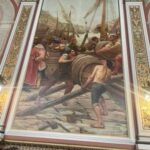
Port wine workers in the palatial Chamber of Commerce
Well, dear readers, Portugal was just as rewarding a destination as you suggested in your many kind messages last month. My college friend Wendy and I had a great time journeying from Porto in the north, down to Lisbon, over to Evora and the agricultural Alentejo region, and then finishing up at the Atlantic coast in the Algarve.
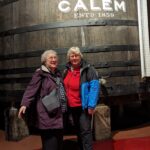
Visiting the Calem Port Wine Lodge
Porto has a fascinating history as the nexus of the England/Portugal connection, going back to the 12th century when crusaders stopped off to give the King of Portugal a hand in his battles, and sometimes stayed to settle. I’m enjoying Rose Macauley’s book, They Went to Portugal, about English travelers over the years who developed the port wine trade, fought against Napoleon during the Peninsular campaigns, and cultivated a craze for Portuguese literature in the 19th century.
The cobblestone streets were steep and slippery, but it’s a city of manageable size for the tourist. I especially enjoyed being at the monastery on the heights where in 1809 Wellington, having beaten the French, coolly sat down to finish the dinner abandoned by Marshall Soult.

Pastel de natas and another cheesy treat – yum!
We then settled in Cascais, about 20 miles west of Lisbon. It was a center for espionage during World War II, when Portugal’s neutral status allowed spies from all nations to gather at the Palacio Hotel. Dejan Tiago-Stankovic’s novel Estoril, translated by Christina Pribichevich-Zoric, is an unexpectedly charming fiction of this period. It was a treat to view the Casino Estoril, which served as the setting for James Bond in Ian Fleming’s Casino Royale. The Lisbon Route by Ronald Weber is a historical treatment of the many figures who made their way through Portugal at this time, including the Duke and Duchess of Windsor (whom Hitler ordered to be kidnapped—didn’t happen). Naturally, on the flight home, I watched “Casablanca.”
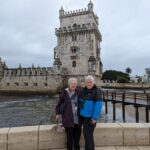
At Tower of Belem, Lisbon
Every tourist to Lisbon is taken to the Tower of Belem and the monument to the Discoveries, originally created by Salazar in 1940 to inspire the Portuguese people to stand fast during the war. I enjoyed seeing Philippa of Lancaster, the English wife of King Joâo I and mother of Henry the Navigator, right up there with the other figures in Portugal’s great voyages to connect Europe with the rest of the world.

Rossio Square with its optical illusion pavement
We walked around Rossio Square, where popular demonstrations during the Carnation Revolution of 1974 helped topple the “New State” dictatorial regime. The country is preparing to celebrate the 50th anniversary of this peaceful event next month. Barry Hatton, in his book, The Portuguese: A Modern History, is very interesting on why this revolution succeeded without serious bloodshed. He calls the Portuguese “gentle anarchists.”
An election was in progress during our visit. An editorial that I was able to struggle through with my new Portuguese was titled, “Can Portugal be governed?” This seems like a telling question. For instance, after King Carlos I was assassinated, and a republican form of government established in 1911, there were 45 governments in 16 years. A divided legislature affects many countries in the world today, including our own. It will be interesting to see how the new government proceeds.
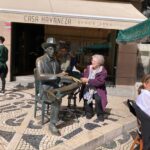
With poet Fernando Pessoa
In Lisbon we lunched at A Brasiliera, a famous café in the Chiado district that served as a center for the intelligentsia. It was a favorite of Fernando Pessoa, a prolific author who wrote under many pseudonyms and has been called “the best four poets of the 20th century.” I bought a copy of his Mensagem in Portuguese and English, and was tickled to have a photo with his statue.
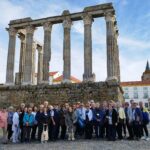
Our group at Temple of Diana with Maria
The next day we set off through the Alentejo, visiting a cork factory and ending up in Evora. This UNESCO World Heritage city contains the famous “Chapel of Bones,” a gruesome reminder of human mortality. The inscription reads, “We who are bones lie here awaiting yours.” The second-century Temple of Diana is apparently a temple to an emperor, not a goddess.
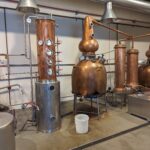
Shariz gin distillery equipment

Exploring the Rocim wine casks
We continued on from Evora to visit a craft gin refinery at 10 in the morning, followed by a tasting, and a winery at 11:30, followed by a light lunch and wine tasting. Not the usual way to start the day! Shariz gin and Rocim wines are produced on too small a scale to be available in the US, but both were delightful. All the demonstrations were well arranged and most interesting, visiting creators who are deeply dedicated to their craft.
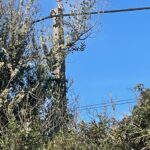
Hoopoe in the Algarve
We finished up with three days in the Algarve, staying at Lagos right on the beach, and venturing to Faro and Tavira. Wendy arranged for a private bird-watching tour, and saw 40 birds she had never seen before, including a hoopoe. We had the pleasure of a cooking demonstration and a delicious lunch cooked in a cataplana (a special kind of Portuguese pot). It included chicken, peppers, and whole spices—cinnamon sticks, cardamom, star anise. I bought some carob liqueur to take home. Couldn’t pack the Portuguese desserts, so I did the best I could on the spot with the delicious “doces” — my sweet tooth went wild.

Cathedral at Faro, capital of the Algarve
The Cathedral at Faro was beautiful, maintained with love and covered inside with gold leaf from Brazil. The gold is also a reminder of Portugal’s colonial past and the sad years of slavery and exploitation. It contains a clue as to why Portugal’s world status fell so rapidly in the 18th and 19th centuries. Those riches were sunk into castles and churches, not invested for the growth of the country.

Maria, our tour manager
It was my first time ever on a tour, and I was astonished at how much we were able to take in. Since Thomas Cook went under during the pandemic, Collette is now the oldest established tour company in the world. The arrangements were first-rate. We were a large group of people (39) and were following a schedule. But free time was included, and our tour manager (from the Azores) was knowledgeable, organized, and kind. It was a great experience.
The Portuguese we met were just as amiable and helpful as their reputation. The food was delicious. The country is only 350 miles long, but it offers a fascinating spread of landscape and history. I can see why 24 million tourists came to Portugal last year (when the population is 10 million!). I am very grateful to have been one of them myself, and I thank you readers again for all the suggestions and good wishes you sent. If you have further thoughts, write to me here!

Cabo da Roca, westernmost point of continental Europe.
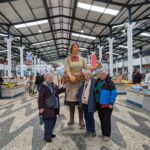
In Setubal market with the flower seller
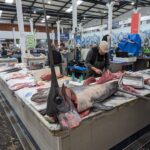
The fish market offered an abundant variety of seafood.
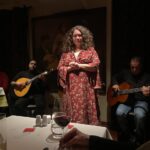
Fado was fabulous – note Portuguese guitar to the left
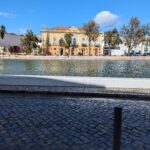
Tavira, very close to Spain
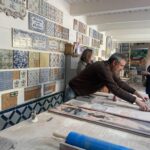
Learning how hand-made azulejo tiles are prepared.
